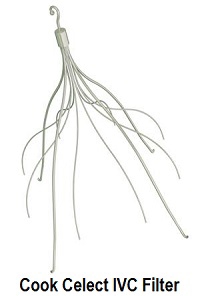 Retrievable IVC filters are supposed to be temporary, used for the short period of time in which a person – contraindicated for blood thinners – is in danger of developing life-threatening blood clots. After the clotting danger passes, the filters are supposed to be removed. But these temporary filters are seldom removed. The result is that patients – many of them trauma victims who don’t even know they have a filter – often suffer conditions every bit as life-threatening as the clotting danger IVC filters are marketed by their makers to prevent.
Retrievable IVC filters are supposed to be temporary, used for the short period of time in which a person – contraindicated for blood thinners – is in danger of developing life-threatening blood clots. After the clotting danger passes, the filters are supposed to be removed. But these temporary filters are seldom removed. The result is that patients – many of them trauma victims who don’t even know they have a filter – often suffer conditions every bit as life-threatening as the clotting danger IVC filters are marketed by their makers to prevent.Retrievable, “temporary” filters typically remain in the patient’s vena cava far beyond the point where they should have been removed. Retrievable IVC filters are not retrieved at all, in most cases.
Failure to Remove IVC Filters a Problem
A study published in Medscape noted that less than 10% of retrievable IVC filters were removed, even though the blood clotting indication (for which the filter was placed) was no longer present. A Medscape piece published Dec. 13, 2011 noted:
“Less than 10% of retrievable inferior vena cava (IVC) filters are removed from patients at one large US trauma center, despite the fact that the indication for the filter placement is no longer present at discharge. The researchers also observed that one in five patients could not have the filter removed, making this a “common and under recognized problem.”
This under recognized problem of failing to remove a temporary filter can create problems every bit as dangerous as the problems filters are marketed to prevent. Retrievable IVC filters not retrieved in timely fashion can create life-threatening peril for the person implanted.
Patients unaware of IVC Filter Implant
Many people with an IVC filter unfortunately don’t even know they’re in potential peril. Many are never told and consequently don’t even know they’ve been implanted with an IVC filter. In the study cited in Medscape, roughly half of the filters were implanted after trauma, blunt trauma, motor-vehicle collisions, penetrating trauma, and falls. Trauma patients are often never told by a doctor or anyone else that they have been implanted with an IVC filter.
Unretrieved IVC Filters Unsafe for Long-Term
Leaving filters in too long can cause several problems. One clinical study published in 2012 found that as many as “20%-40% of filters cannot be removed by using standard methods because they have become firmly embedded along the vessel wall.” In that study, doctors Kuo, Robertson, Odegaard and Hofmann concluded that, “Our data indicates that the IVCF’s are unsafe for long-term.”
A 2014 study of IVC filter perforations using CT scans found that perforations grew worse over time. The longer IVC filters were left inside a person, the greater the chances that person in the study was likely to suffer perforation. Ohio State Interventional Radiologist & Biomedical Engineer Dr. Joshua D. Dowell and several other researchers found, “Celect Inferior Vena Cava Wall Strut Perforation Begets Additional Strut Perforations.” More and more of the 91 patients who underwent sequenced CT scans suffered strut perforations. (Struts are the ‘legs’ or ‘spokes’ of the filter). the study found:
36% showed strut Perforation at 1st CT
66% showed strut Perforation at 2nd CT
79% showed strut Perforation at 3rd CT
The results of this study strongly suggest that one should have an IVC filter removed as soon as possible. The study clearly shows that the longer an IVC filter is left inside a person, the greater the chances that filter will perforate the vein, which in turn can make the filter more difficult, if not nearly impossible, to then remove.
To be continued. . .
Related
- IVC Filter Lawsuit
- Bard IVC Filter Attorney
- IVC Filters Unreported

by Matthews & Associates




